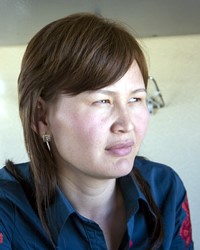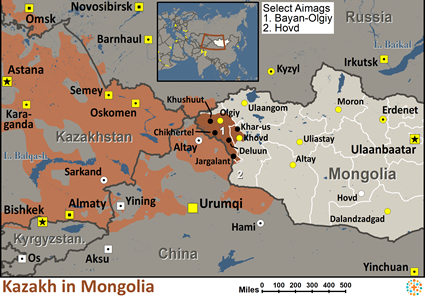The Kazakhs of Mongolia belong to a larger group of people who live primarily in present day Kazakhstan. Traditionally the Kazaks were semi nomadic, equestrian tribal people who roamed the Ural Mountains and the regions of North and Central Asia of Eurasia. Only people of the Kazakh ethnic group are called Kazakhs, while the term Kazakhstani refers to the people of Kazakhstan, inclusive of all ethnic groups living in the country. Likewise, not everyone in Mongolia is Mongol; some are Kazakh and other ethnic minorities. The Kazakhs who now live in Mongolia make up the largest non-Mongolian ethnic group in the country. However their number is decreasing since many are emigrating back to their homeland, Kazakhstan. Kazakhs developed a distinct ethnic identity in the late 15th and early 16th centuries. As several of the clans formed a federation for mutual protection, they took on an ethnic identity of their own. Through the years, the Kazakhs closely preserved their culture by keeping an epic tradition of oral history. During the late 19th and early 20th centuries, the annexation of Central Asia by Russia and the Soviet Union respectively, resulted in many Kazakhs fleeing the steppes to Europe and Asia, with many later becoming citizens of other countries, especially China and Mongolia.
Even though the Kazakhs were subject to the same purges, forced collectivization, and cultural and religious destruction as other Mongolians, they survived with their culture and ancient way of life somewhat intact. This was due to their determination and their distance from Ulaanbaator, Mongolia's capital city. Mongolian Kazakhs are traditionally semi-nomadic pastoralists, herding sheep, goats, yaks, camels, and horses. This means that a Kazakh household moves with their herds to different pastures for each of the four seasons. Some households move only twice, once in the spring to the summer pastures and again in the fall back to the winter pastures. Most families return to specific pastures year after year with use of that pasture being passed down through families. Kazakhs live in yurts (gers), a dome shaped tent made of felt and wood. Their gers are larger and taller than a Mongolian ger. This is because Kazakhs move to small, mud-brick houses in winter, which are easy to heat, and they build their (summer) yurts with more room and airflow. Today, Kazakhs watch Turkish or Kazakh soap operas beamed into their yurts (about a third of yurts) thanks to satellite dishes and solar panels outside. Kuz (a horse meat sausage), Bes Barmak, and Airag (fermented mare's milk) are a few of their staples. Women do not drink alcohol and there is very little alcoholism among men. The Kazakh women create the world famous, intricately embroidered wall hangings (tuskies) that is hung on yurt walls. A typical ger may have 5 to 7 wall hangings that can take 200 hours to hand stitch each. The curves on them depict the curving horns of the goats and this design is used in a variety of their traditional clothes, home furnishings, and accessories. All Kazakhs keep close ties to extended families. Their tradition does not allow them to marry anyone related within 9 generations. Neither do they intermingle or intermarry with other ethnic groups in Mongolia. As a result, upon meeting each other, Kazakhs always tend to enquire regarding the tribe they belong to. The Mongolian Kazakhs have integrated many Mongolian festivals within their own traditions. The biggest celebration is Nauryz, the New Year, which is celebrated in March. Kazakhs still play the ancient sport of eagle hunting, and Buzkashi (fighting over a goat carcass). Under socialism in Mongolia, the pastoral economy was collectivized, and they were given access to modern education, health care and public infrastructure including social welfare policies. The nomadic economy, once strongly influenced by traditional gender roles (where men herded and women cooked, cared for children and prepared textiles), saw a gradual transformation of gender roles and relations. Individuals and families who have adapted well to Mongolia's new economy are less likely to consider moving to Kazakhstan. Successful middle-aged business owners and herders are relatively satisfied with life in Mongolia while their children consider working or attending school or university in Mongolia, especially Ulaanbaatar or Kazakhstan. The incentives provided by the Kazakhstan government for education to the homeland lure many young people to Kazakhstan. While many move with their families, others join extended family relations in Kazakhstan for the duration of their education.
Because of their nomadic pastoral lifestyle, Kazakhs kept an epic tradition of oral history.
Mongolian Kazakhs are predominantly Sunni Muslims, but few are devout. A small but growing proportion only practices the basic Muslim tenets of Namaz and fasting during Ramadan. Kazakhs might also practice lamaistic Buddhism and shamanism, and there is a growing number of young people who consult shamans for help with various issues. Atheism is also on the rise. Even though the Mongolian church began in the 1990s, there has been exponential growth. There has been growth among Evangelicals, but there are also cults.
The Kazakhs in Mongolia need the chance to find their way to the cross and the empty grave.
Ask the Lord to send long term laborers to live among Kazakhs in Mongolia and share the love of Christ with them. Ask the Holy Spirit to open the hearts of Kazakhs, so that they will be receptive to the gospel. Pray that Christian who are filled with the fruit of the Holy Spirit will have open doors to share the gospel with the Kazakhs. Ask the Lord to raise up a church planting movement among Kazakhs in Mongolia.
Scripture Prayers for the Kazakh, Qazaq in Mongolia.
| Profile Source: Joshua Project |


























